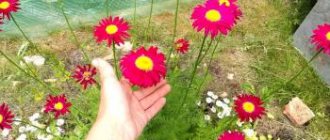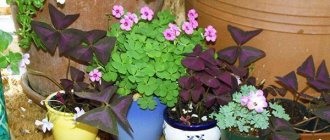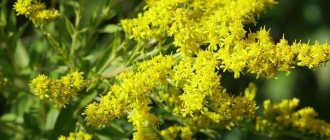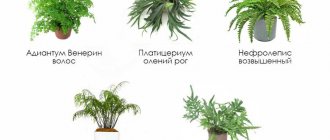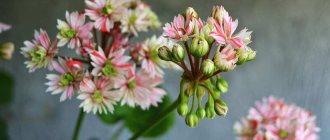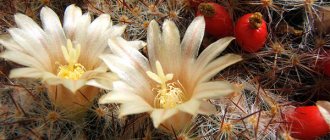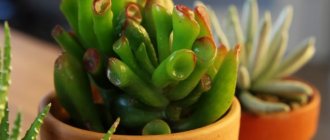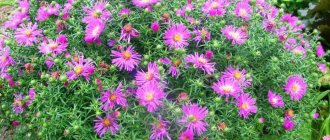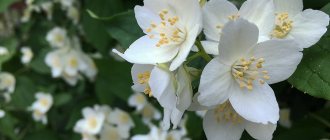Ferns are one of the oldest plants on our planet that have retained their basic characteristics. They appeared 400 million years ago and at that time reached enormous sizes.
In the modern world, ferns are no longer so majestic and do not dominate the plant world. But, despite evolutionary changes, their diversity is amazing.
This culture is quite common in the wild and can surround people everywhere: it grows well on rocks, in swamps, in deserts, and in water. Ferns are distributed throughout the planet, but their favorite areas are those with warm and humid climates: the tropics and subtropics.
Interesting. Ferns are very popular as garden and indoor plants.
Fern
What flowers are there that look like ferns, what are they called, photos?
indoor or garden flower that looks like a fern
. Strangely enough, there are quite a few such flowers, but basically these are all indoor plants that really resemble a fern (some are even its species).
Nephrolepis - resembles a fern and looks very beautiful.
Davallia - the leaves of this plant are similar to fern, but they are smaller in size.
Blekhnum is also similar to a fern, but the leaves are directed upward. It is often found not only in apartments, but also on the street.
All ferns love to grow in shady places, because this is how they grow in nature. There are quite a lot of plants similar to ferns. They grow both in the garden, on the plot, and at home. Since they do not need bright light, the plant can be placed anywhere in the room: on a table, cabinet, shelf, floor, etc.
For example, there are these:
Adiantum Venus hair or Adiantum Ruddy. Its leaves look like shaggy triangles.
Asplenium nest is somewhat reminiscent of mother-in-law's tongue:
Different types of fern Nephrolepsis, which is probably most often found in homes and is most associated with ferns (sercefolia, sublime, Marisa, etc.)
In some ways it seems to me similar to the Adiantum fern. It is popularly called “curly fern” and belongs to the adiantum family. In nature, it is widespread, for example, in South America. The plant looks gentle and elegant. Some gardeners even manage to grow it at home, despite its whimsical nature.
Davallia. The plant is an epiphyte and can even live quietly in indoor conditions.
Grows in Asia, the Canary Islands and other tropics. The greenery of Davallia looks very delicate and really resembles a fern. The roots of the plant hang down from the pot and because of this it is nicknamed “rabbit’s feet”. Very unusual.
Blekhnum are decorative and unpretentious plants, very popular in apartments.
It grows quite quickly, is unpretentious, requires regular watering and periodically removes old leaves. Not very tall - 40 cm and leaf size up to 60 cm. Requires replanting every year. Does not like sunlight, place in shade or partial shade.
Polypodium is an unpretentious plant and very easily adapts to new conditions, watering should be moderate, it tolerates drought well, with excess watering it can rot, which is why there should be a thick layer of drainage at the bottom.
The plant is replanted by cutting the rhizome, usually in half, and the plant is removed to a dark and warm place for several days.
Fern growing conditions
All types of ferns require approximately the same care when kept at home. Since Nephrolepis is considered the least demanding and widespread, the cultivation technology is worth considering using its example.
Nephrolepis sublime
Choosing a place in the house
If we consider Nephrolepis, it grows well in the forest and tolerates shade well. However, this does not mean that similar conditions need to be created for the home flower fern. The plant develops better when exposed to daylight with glimpses of sunlight.
Types of ferns
Ferns are one of the oldest plants on our planet that have retained their basic characteristics. They appeared 400 million years ago and at that time reached enormous sizes.
In the modern world, ferns are no longer so majestic and do not dominate the plant world. But, despite evolutionary changes, their diversity is amazing.
This culture is quite common in the wild and can surround people everywhere: it grows well on rocks, in swamps, in deserts, and in water. Ferns are distributed throughout the planet, but their favorite areas are those with warm and humid climates: the tropics and subtropics.
Interesting. Ferns are very popular as garden and indoor plants.
water ferns
It's amazing, but fern can grow even on the surface of the water. Such varieties can often be found in freshwater reservoirs, rivers and streams of India and Southeast Asia. Like terrestrial ferns, they have graceful, complex fronds. Amateur aquarists love them very much, because, without soil, they ensure the supply of oxygen to the water, while giving the aquarium a highly decorative appearance.
Among such aquatic species, species from the Salviniaceae family are most common. In tropical countries they are even called river weeds. Reproducing very intensively, they take over vast expanses of water, preventing the movement of river vehicles, the operation of hydroelectric power stations, and clogging the nets of fishermen while fishing.
Another widespread type of ferns growing on water. Unlike Salviniaceae, they, on the contrary, belong to useful plants. Rice growers specially plant them on rice plantations because they suppress the growth of weeds, and their roots and leaves are capable of accumulating nitrogen.
general characteristics
Despite the fact that ferns are flowering plants, they never bloom, and in appearance they can hardly be called flowers.
The structure of ferns is peculiar - the root is poorly developed and superficial. The above-ground part of the plant is unusual - it can hardly be called leaves, flowers or branches. In botany, a special name is used - fronds or flat branch. But in the process of evolution, a real leaf begins to emerge.
Plants reproduce by spores or vegetatively. At home, the simplest method of propagation is dividing the bush.
Interesting! The Fern class, or True ferns, belongs to the Fern division and amazes with its diversity - ferns are low and tall, in the form of grass, shrubs and trees, of various colors and shapes. The variety of this plant has 8 subclasses, approximately 300 genera and about 10 thousand species.
Varieties of indoor ferns
Ferns are the oldest plants, appearing long before flowering plants. Contrary to all sorts of legends and folk tales, they do not bloom, but reproduce by spores, which are usually located on the inside of the leaf.
Thanks to their original appearance, ferns can easily decorate a room for any purpose, a residential veranda, a doctor’s office, a household appliance store, or an alpine slide in a park.
The external characteristics of these plants are easily recognizable even by inexperienced gardeners. However, only a few know that the variety is represented by more than 10,000 species , of which more than 2,000 are considered indoor.
Classification of Fern families
Order Osmundaceae
Family Osmundaceae. One of the most ancient groups of ferns. Characterized by very large leaves.
Order Hymenophyllaceae
Family Hymenophyllaceae. Characterized by very thin, almost transparent leaves. Lives in dark and very humid places.
Order Glachenillaceae
Important! Family Dipteriaceae, Matoniaceae. Endangered species. They are the remnants of an ancient family, living in New Guinea and Indonesia.
Order Schizeynye
Family Schizeaceae, Logodium. It stands out for its huge size - up to 30 m.
Order Salvinaceae
These are water ferns.
- Family Marsiliaceae. Distributed in water and coastal areas.
- Family Salvinaceae. They live on the water surface.
Order Cyathaeaceae
Family Tyrsopteris, Plagiogyria, Cybothium, Cyathaeaceae. Tree-like plants.
Order Multihorned
Family Centipedes, Shieldaceae, Onocleaaceae, Dennstedtiaceae, Kostenzoaceae, Telipterisaceae, Woodsiaceae, Derbyaceae. The most numerous subclass of culture.
On a note! Centipede or Polypodiopsid is another name for the fern.
Beneficial features
Different types of curly fern are used for indoor landscaping. This is a fairly unpretentious plant that grows well in warm and bright apartments and offices. In addition to the pleasure that comes from seeing lush green leaves, ferns have beneficial properties. It cleans the air well, absorbing harmful toluene and formaldehyde from the atmosphere, which is especially important for high-traffic areas - classrooms, offices, hallways in commercial buildings.
There is also an opinion that indoor curly fern neutralizes various microbes that cause diseases. These useful qualities only add to its attractiveness in the eyes of all lovers of home gardening.
House fern species
Due to their effectiveness and ease of care, representatives of the fern family have become popular as indoor plants. They will add zest to any interior. In addition, fern, as a house flower, improves the atmosphere in the house and purifies the air.
Popular types of indoor ferns:
- Nephrolepis. An unpretentious but beautiful compact bush. Feather-shaped fronds, soft green. Grows quickly and does not cause allergies. Care consists of regular abundant watering and spraying, providing diffused lighting, and a temperature of 18-22 degrees.
- Davallia. Original plant. Small in size - 15-20 cm, bright green in color. The main feature of the fern is the root system - the roots grow above the pot, as if enveloping it. Thanks to their pleasant fluffy structure and rare silvery color, the roots look unusual and attractive. Maintenance requirements are minimal: bright light, regular watering, light soil with a drainage system, temperature - 20-25 degrees.
- Multi-row. A very beautiful home flower, which is often found in the wild. Features of the species are the rich green color and shiny surface of the fronds. Needs constant soil moisture and a shaded place to grow. The optimal temperature is 15-25 degrees, but can withstand frost.
- Pelley. Low but spreading bush. The leaves are small and round. The shaft is dense and shaggy. The difference between the species is its adaptability to drought. Requires spraying, indirect sunlight and a temperature of 20-25 degrees.
- Pteris. Quite a popular variety of fern. It stands out for its unusual shape of branches and various leaves, more like hare's feet. The coloring is also original – green, with a white stripe in the middle. They are not much of a hassle to care for. They develop well at 13-23 degrees, but do not tolerate drafts well.
- Circomium. The shape of the plant is unusual for a fern - the leaves are round, slightly elongated at the tip, wide, very thin. It grows slowly, but tolerates dry air well. Loves shade and warmth up to 25 degrees.
A separate group are aquarium ferns - bright representatives of aquatic families. These are quite attractive plants that can decorate any aquarium and add variety to the life of fish. Well-known species of this group are Thai Vindelova, Thai angustifolia, pterygoid, Indian, Bolbitis Gedeloti.
Carnivorous plants
I would single out insectivorous plants as a special group. They have only recently appeared in home collections. Their exoticism scares off most flower growers, but at the same time their originality attracts. Most often, Venus Flytrap (Dionea), Darlingtonia and Nepenthes are grown in apartment conditions.
- Growing palm trees from seeds - how to increase the chances of seed germination?
So, if you want to choose the right soil, watering regime and temperature, fertilizers, replanting schedule, and propagation systems that a particular flower needs, first of all determine which group this flower belongs to.
Garden types of fern
Interesting! Ferns are clear proof that a beautiful and original plant can develop without the formation of flowers. The varied shape of the leaves, a riot of colors: from pale to bright green, interspersed with other colors will bring some zest to any garden.
Description of popular decorative types:
- Female Kochedyzhnik. It stands out with its delicate fronds of soft green color. It grows about a meter tall. Loves shade and moisture.
- Male shieldweed. The most popular decorative fern. Characterized by dark green shiny fronds. It grows a little more than a meter.
- Red rosemary. A special feature of this species is the original color of young fronds - the color of old gold.
- Polygonal bristlecone. Despite the fact that it is quite large, the leaves are delicate and delicate, and stand out for their absolute symmetry.
Fern-like flowers
There are many plants that closely resemble ferns in leaf shape:
- Biophytum. Decorative compact plant in the form of a palm tree;
- Zamia. Compact flower with a dense stem and feathery oval dark green leaves;
- Aeschynanthus. An ampel plant, valued for its beautiful flowers, quite difficult to care for;
Eschynanthus
- Cycas. Sago palm, unpretentious in care;
- Palmate encephalartos;
- Grevillea. Hardy ornamental plant with fern-like leaves;
- Hamedorea. Bamboo palm loves moisture and warmth.
Exotic varieties of fern
Due to the large number and diversity of ferns, many exotic, unusual species of this culture have become known:
- Nippon kochedednik, known for its unusually colored fronds.
Varieties:
- Pictum – purple branches;
- Silver falls – silver color;
- Ursulas red – purple fern.
- Platycerium (Deer Antler, Flathorn). A very unusual species, the fronds actually resemble deer antlers in shape, which is why they began to call it that.
Interesting! Thanks to their original and unique shape, colorful colors, and ease of care, ferns have won the love and respect of many gardeners. They are able to add variety and decorate any landscape.
Transfer
Indoor curly fern must be replanted after purchase, since it is sold in a specific nutrient substrate that is unsuitable for long-term use. After the purchase, 10-15 days should pass, after which the plant must be moved to a larger pot and in proper suitable soil. After the fern has taken root, you can begin to introduce fertilizing.
Adult specimens are transplanted once a year, in the spring, into a larger container. In this case, it is advisable to free the roots from the clod of earth, although this procedure can damage them.
Indoor fern: description
Indoor fern belongs to the family of vascular spore plants. Indoor ferns are a large group of plants that differ in the shape of their foliage and the shape of the plant itself. There are decorative species whose foliage is carved and cascades down. In other species, the foliage overlaps each other, while in others it is collected in rosettes.
Ferns are an intermediate link between moss, algae and gymnosperms. They have preserved their original structure from ancient times, but were able to adapt to modern living conditions.
Their foliage can be curly, feathery, or many times dissected. The leaves that have just appeared are twisted into a spiral, and as they grow, this spiral unwinds and darkens. The root system of ferns, like many plants, is located in the soil layer.
Names and descriptions of indoor and garden varieties
There are garden (forest) and indoor ferns. In biological taxonomy, up to 48 plant families are distinguished, including about 590 generic representatives and more than 10.5 thousand species.
Fern is an environmental indicator (an indicator of cleanliness) and a home health worker. It purifies the air, neutralizes toxic compounds (toluene, xylene, formaldehyde) just like Chlorophytum.
There is a classification based on habitat and biological structure of exotics:
- The marsh shield prefers swampy, damp areas; the branches resemble palm leaves.
- The Ussuri centipede grows in rocky areas and lives on trees as an epiphyte. A special feature is the integrity of the sheet plate. In summer, in dry hot weather, the leaves curl into a tube; southern subspecies grow only on trees.
- Salvinia and Marslelia are representatives of aquatic ferns that grow in floating lawns directly on the surface of the water. The leaves of Salvinia are similar in structure to the leaves of acacia, and the leaf blade of Marslelia resembles clover leaves.
- Common bracken grows in deciduous or coniferous forests; in nature it grows to 1-1.5 m in height. The leaves are large, triangular, rounded, the petioles are powerful and long. The stem is hidden underground. It reproduces mainly by rhizomes.
In 2006, University of California botanist Alan Smith proposed a new classification. Divided all types into 4 main classes:
- Psilotaceae are epiphytic species without roots.
- Horsetails are vascular plants.
- Marattiaceae are an ancient subgroup of the monotypic class.
- True ferns are polypodiopsids, polypodiopsids.
Indoor varieties number about 2 thousand species. They are more adapted to home keeping.
We bring to your attention a description of the most unpretentious and common types.
Polystichum
The most extravagant and beautiful species of the Shchitovnikov family, there are more than 175 generic varieties. In its natural environment it lives in damp coniferous or broad-leaved forests, on the slopes of rivers and ravines. Feature – the segments are arranged in rows. It is planted in rock gardens, and shady places under the canopy of large trees are decorated with the plant.
The most common varieties:
- Brown - up to 60 cm tall, grows slowly.
- Verkhoplodny - leaves are linear, up to 60-70 cm long.
- Protected - lanceolate foliage reaches 1 m in length.
- Spear-shaped - leathery leaves, the bush grows up to 60 cm.
Davallia
The semi-deciduous or deciduous perennial epiphyte is named after the Swiss botanist Edmond Daval. In everyday life, the decorative tropical resident is called Hare's (Squirrel's) feet or Deer's foot. Characterized by rapid growth.
In nature, it lives in southern and temperate climates - in southeast Asia, the Caribbean and Canary Islands, and Australia.
The bush is medium in size, the stems and rhizomes are fleshy, long, covered with scales, and store water and nutrition.
They cling to trees, can crawl over rocks, and live like lithophytes. The leaf blades are pinnate, dissected, triangular. The structure is leathery, the edges are lobed. The leaves are openwork. Subspecies Mariesa, Five-leaved, Canary Davallia reproduce by spores and stem division.
Nephrolepis
The most common indoor species, it has 30-40 subspecies. Looks good in offices and large rooms, official institutions. Originally from tropical regions of Africa, Australia, America.
Shadow epiphyte (does not tolerate open areas) is adapted to terrestrial growth. The rhizome is short and develops vertically. The fronds are feathery, complex, and large in size.
The length of an adult soft green leaf reaches 2-2.5 m. In apartment conditions it grows up to 70-80 cm in length.
The foliage is openwork, decorative. Propagated by shoots or division of the bush.
The most popular hybrids:
- Sublime - curved leaves grow up to 60-75 cm in length; The fronds are collected into a rosette.
- Cordifolia - segments of the leaf blade are rounded and overlap each other.
- Urinary is a large variety, the leaves stretch up to 2.5 m.
Kostenets (Asplenium)
The perennial grows on rocks and rocky soils and is common in Asia and Europe. The Kostentsov genus includes up to 700 subspecies of Asplenium. The height of the bush is from 30 cm to 1 m. The bush is lush, even at home it grows in diameter up to 90-100 cm. The leaves are narrow and linear. The peculiarity of the structure is that the fronds consist of a large leaf with a strong and flexible core.
On the territory of Russia there are small terrestrial species that live on rocky and rocky terrain.
Common varieties:
- Altai - broadly lanceolate small leaves up to 7 cm in length, rich green color, short rhizome.
- Hair-shaped - grows in the Caucasus, the leaves are evergreen, pinnate, round, up to 10 cm in length. The root is fibrous, weak.
- Green – prefers mountainous areas. The rhizome is dense. The leaves are linear, narrow, up to 10-15 cm long, pinnate in structure, rich green in color.
Pellaea
Natural growth zone - New Zealand, Africa, South America, Canada, USA. There are more than 40 varieties. The bush is medium-sized, up to 60 cm in height. Dense shoots-leaves are united by a voluminous rosette.
The rich green fronds with individual leaves have an oblong shape. The rods and shiny petioles are dark in color. The rhizome is creeping.
Popular subspecies:
- Naked - leaves are linear, up to 35 cm in length, pinnate, petioles bare, brown in color.
- Dark purple - leaves containing spores grow up to 50 cm; The color of the leaf blade is greenish with a bluish tint, the petioles are purple-black.
Platycerium "Deer Horn" (Platycerium)
It is called Ploskogor. The spectacular epiphyte belongs to the Centipede family. There are more than 15 species. Prefers semi-shaded places. The peculiarity of the variety is large, divided lobed stems and leaves that resemble deer antlers in appearance. The color is bright green. The length of the frond in nature is up to 70 cm.
Popular subspecies: Double-forked - planted in winter gardens, on alpine hills, develops well in apartments. The maximum leaf length at home is 30-40 cm. The covering leaves are rounded, tightly pressed to the support. The spore-bearing leaves are elongated, well branched, and light green in color.
Pteris
The most unpretentious subtropical inhabitant. He was nicknamed Orlyak for his bizarre appearance. Classified as a terrestrial species. In nature, it lives in the Mediterranean countries, southwest Europe, Iran, India, and the Caucasus. The root is short and scaly. The leaves are feathery, variegated in color, collected in a rosette bunch. The sori are densely set along the edges of the feathers.
Common subspecies:
- Cretan or Ribbon Fern - grows in the southern regions of the CIS in open ground. The height of the dense bush is 35-45 cm, in diameter up to 30-40 cm. The fronds are soft green in color, feathery. The leaves are belt-shaped, grow oppositely, in 6-7 pairs, simple or forked. The spore-bearing leaves are narrow, entire - slightly curled along the edge.
- Hybrids Albolineata and Wimsettii - differ in variegated colors, the upper leaves are patterned or with a characteristic white stripe on each segment.
Cyrtomium
A rare terrestrial species of the Shchitovnikov family, includes up to 20 species. Natural habitat - southeast Asia, Japan, China, Korea. The peculiarity is that the flowers are unpretentious and hardy; they quickly adapt at home. The root is short and powerful.
The leaves are hard, dense, and overwintering in structure. Dissected into large pointed feathers-lobes. The sori are scattered across the entire surface of the leaf, covered with shields.
Popular varieties:
- Fortune - can grow in open areas in temperate and southern climates. Winters only in warm areas. Grows in shady gardens. The height of the bush is up to 40-50 cm. The leaves are green with a gray tint.
- Crescent is a similar variety.
A distinctive feature is large, wide leaves. Does not tolerate cold, optimal climate zone is 6-7. Does not survive winter in the open air in the Central regions of Russia.
Characteristics of fern species
Graceful foliage, well branched, dark petioles
The foliage is forked at the base, young leaves are pinkish-brown in color.
Adiantum Venus hair
Its thin petioles look like hair, their color is light brown, the foliage is round, small, bright emerald
Grows well in partial shade, requires high air humidity, the foliage has the shape of a gladiator's sword, a vein of a darker shade runs through the center of the leaf, the edges are slightly wavy, can stretch up to 0.6 m in length
The petioles of the plant resemble wires in appearance; they are dark in color; the foliage is pinnate and has a rich emerald color.
The rhizome of this fern is hairy and creeping. On the aboveground part of the flower there are simultaneously wide and narrow foliage
The crown of this fern can grow up to a meter wide. Therefore, it requires a spacious room. The foliage is tough, the main trunk of an adult plant is well developed
The stems of this species can reach a height of up to 2.4 m. The foliage is arched, curved, carved, pale emerald green
The species is not afraid of drought and drafts. The leaves are elongated, carved along the edges, their color is dark emerald.
The foliage of this fern is similar to carrot tops, and the rhizome usually grows out from the soil of the pot.
This species requires a lot of free space, since an adult plant can reach a height of 5–6 meters. Its foliage is leathery and faded green. The trunk is powerful, dark brown in color.
Didymohlena slightly truncated
It also grows well in the shade. The foliage is shiny, leathery, small, truncated, green with a brown tint.
Grows well in the shade, but requires regular watering and high humidity. The foliage is located vertically, its edges are smooth. The stems are long and thin, covered with thin scales.
The foliage can stretch up to 0.6 m in length.
The plant reaches a height of up to 0.3 m, the rhizomes are small. The foliage is round, leathery.
Orchids
Orchids have become very fashionable for growing in apartments. At first, our flower growers did not know the specifics of caring for these flowers. And now they have become as common as plants familiar to us. Although they still require special care, it is not so difficult to provide.
Orchids are distinguished by particularly beautiful flowers (they can be classified as beautiful-flowering). These are epiphytes, so when caring for orchids it is necessary to ensure high air humidity.
In our flower collections you can find the following types of this plant: Paphiopedilum (“Venus’ slipper”), Vanda Orchid, Dendrobium Orchid. But the most popular and widespread is the Phalaenopsis Orchid.
Indoor fern: care at home
One of the most suitable fern species to grow indoors is Nephrolepis. This fern is distinguished by its high decorative properties and good endurance. Its foliage can be dark or light green depending on the lighting in the room and the composition of the soil in the pot.
Types of indoor ferns (video)
Soil and planting capacity
The conditions in which ferns are grown indoors are practically no different from natural ones. And first of all, this concerns the soil, which must be selected for growing any type of fern.
The basis for this mixture is leaf soil with the addition of peat, sand and humus. This soil should have a fairly high acidity and be loose. It is better to put any drainage material at the bottom of the pot, preferably expanded clay. The thickness of such a layer should be 3–5 cm. Drainage is necessary to ensure that moisture does not stagnate in the soil. Stagnation of moisture can lead to rotting of the rhizome. The first sign of such rotting is the appearance of brown spots on the foliage.
curly fern
This is the name for any variety of nephrolepis with curled leaves or feathers with wavy edges. Another popular name is curly fern. All these varieties are derived from Nephrolepis sublime. The most popular varieties for home cultivation are:
- Hillsii - with twice pinnately dissected leaves.
- Superbissima - with triple-cut feathers.
- Smithii - with leaves cut four times.
- Teddy Junior - with wavy leaves.
- Scottii - with curled edges on some leaves.
Propagation of house fern
There are several ways to propagate house fern. The easiest way to propagate ferns is by dividing the bush. Sometimes this plant is propagated by spores. However, this process is too labor-intensive and not always effective. It is much easier to propagate this shrub by dividing the bush. And only under natural conditions do these plants reproduce only by spores.
Typically, such division is carried out when replanting a fern, so as not to further injure the plant.
When the bush along with the earthen lump is taken out of the old pot, the rhizome is carefully examined . The basal rosettes are immediately visible on it. These are babies that are carefully separated from the rhizome along with part of it. These children are given special conditions during transplantation so that they quickly take root and grow.
Home fern flower: description, varieties, cultivation
Among indoor flowers, fern is popular among lovers of decorative greenery. The plant attracts with its beautiful “lace” leaves that form a lush bush. However, the house flower fern belongs to a family in which most of the representatives live in the wild. To keep a plant in a room, you need to know the growing technology, its beneficial and negative properties.
- Description of house fern
- Varieties of house fern
- Fern growing conditions
- Choosing a place in the house
- Temperature
- Flower care
- Fern transplantation, propagation
Main diseases and pests
Usually the plant begins to get sick or is attacked by pests if it is constantly cared for incorrectly.
If the fern is watered with unsettled water, which contains a high content of chlorine, or if it is cold, then a nematode may attack it. At the same time, the foliage begins to turn yellow and fall off. Usually the only salvation is an urgent bush transplant. When transplanting, be sure to treat the fern with insecticides.
If the humidity in the room is low, the fern can be attacked by pests such as scale insects, aphids or thrips. You should spray your plants every day to avoid this. If insects do appear on the foliage, then the fern should be treated with special preparations.
Subtropical plants
Attempts to grow lemons or oranges from seeds were made by our flower growers back when it was impossible to buy them even in greenhouses. And now subtropical fruit plants are frequent representatives of flower collections. Connoisseurs of these flowers even achieve constant harvests of exotic fruits.
Most often grown in apartments: Lemon, Orange, Banana, Pomegranate, Grapefruit. Those who like to experiment even grow Feijoa, Coffee tree or Chinese tea.
Useful tips for growing curly fern
- Sometimes brown growths form on the back of mature leaves. This is not a disease, this is how spores are formed.
- In autumn and winter, feeding should be kept to a minimum, otherwise the green pet will suffer.
- If the leaves turn yellow, begin to dry out and become covered with brown spots on the front side, this may indicate improper maintenance conditions - overheating, proximity to heat sources and insufficient moisture. Such conditions can provoke the appearance of spider mites.
- If the leaves of the fern turn pale and change color from intense green to yellow-green, then most likely it is due to excess light or poor nutrition.
- Limp and translucent leaves indicate that the plant needs shade.
- Feathers become brown and wrinkled due to drafts, cold and watering with hard cold water.
If you take good care of the fern and respond in time to changes in appearance, then most problems can be avoided or the situation can be quickly corrected.
Reproduction
At home, ferns are propagated in two ways: division and spores.
Disputes
The sequence of the procedure is as follows:
- Spores are scraped off the inner surface of the leaf blades;
- the taken crop is evenly distributed over the surface of the moist soil;
- the container with the plantings is covered with film or glass, after which it is placed in a dark and warm place (the temperature should not be lower than + 22 °C);
- Every day the greenhouse is opened slightly for 1 hour for ventilation;
- regularly moisten the soil;
- after the first shoots appear (after 4-12 weeks), the container is transferred to a lighted place and opened;
- after young ferns grow, thinning is performed, eliminating weak specimens;
- mature plants are planted in separate pots (2-3 trunks per container).
Division
The procedure is performed by hand, carefully dividing the bush in half or into several equal segments.
It is very important to prevent damage to the root system.
Each individual part must have a growth point: their number determines how quickly the division will take root.
